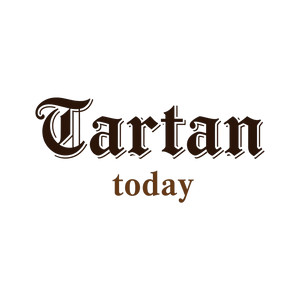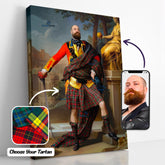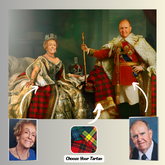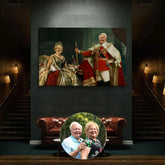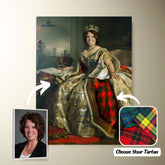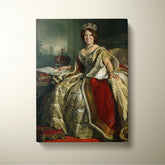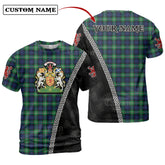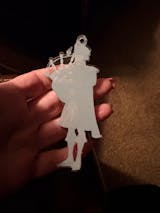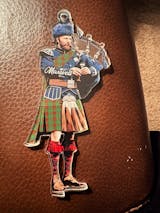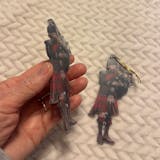-
Personalized Clan Bannerman Tartan Bagpipe Ornament with Custom Name – Scottish Christmas Tree Decoration EY53
Personalized Clan Bannerman Tartan Bagpipe Ornament with Custom Name – Scottish Christmas Tree Decoration EY53Celebrate your Scottish heritage with this unique wood & acrylic tartan ornament. Perfect as a personalized Christmas decoration or a meaningful gift for friends and relatives on special occasions such...- From $19.99 USD
$25.99 USD- From $19.99 USD
- Unit price
- per
Save $6.00 -
Personalized Clan Bannerman Tartan Drummer Ornament with Custom Name – Scottish Christmas Tree Decoration QI52
Personalized Clan Bannerman Tartan Drummer Ornament with Custom Name – Scottish Christmas Tree Decoration QI52Celebrate your Scottish heritage with this unique wood & acrylic tartan ornament. Perfect as a personalized Christmas decoration or a meaningful gift for friends and relatives on special occasions such...- From $19.99 USD
$25.99 USD- From $19.99 USD
- Unit price
- per
Save $6.00 -
Personalized Clan Bannerman Tartan Bagpipe Ornament with Custom Name – Scottish Christmas Tree Decoration WP57
Personalized Clan Bannerman Tartan Bagpipe Ornament with Custom Name – Scottish Christmas Tree Decoration WP57Celebrate your Scottish heritage with this unique wood & acrylic tartan ornament. Perfect as a personalized Christmas decoration or a meaningful gift for friends and relatives on special occasions such...- From $19.99 USD
$25.99 USD- From $19.99 USD
- Unit price
- per
Save $6.00 -
Personalized Clan Bannerman Clan Crest Tartan Santa Ornament – Custom Acrylic Christmas Decoration LR38 - Bannerman
Personalized Clan Bannerman Clan Badge Tartan Ornament – Custom Acrylic Christmas Decoration LR38Celebrate your Scottish heritage with this unique wood & acrylic tartan ornament. Perfect as a personalized Christmas decoration or a meaningful gift for friends and relatives on special occasions such as Christmas,...- From $19.99 USD
- From $19.99 USD
- Unit price
- per
-
Bannerman
-
Custom Name Clan Bannerman Tartan Garden Flag with Clan Crest and the Golden Sword of Courageous Legacy UF72 - Bannerman
Custom Name Clan Bannerman Tartan Garden Flag with Clan Crest and the Golden Sword of Courageous Legacy UF72 Immerse your space in the rich heritage of Scotland with our Tartan Garden Flags, exclusively from Tartan Today. Featuring vibrant tartan and Scottish heritage designs, these garden...- From $34.45 USD
- From $34.45 USD
- Unit price
- per
-
Bannerman
-
Clan Bannerman Tartan Scotland Map Canvas “Tartan Runs Through My Veins” Wall Art FR39
Clan Bannerman Tartan Scotland Map Canvas “Tartan Runs Through My Veins” Wall Art FR39Celebrate your Scottish heritage with this striking canvas print featuring the map of Scotland filled with Bannerman tartan, paired with the bold phrase: “Tartan Runs Through My Veins.” Whether you're honoring...- From $35.05 USD
- From $35.05 USD
- Unit price
- per
-
Personalized Clan Bannerman Tartan Shirt with Scotland Coat of Arms & Custom Name CG69 - Bannerman
Bannerman Tartan Shirt with Scotland Coat of Arms & Custom Name CG69Celebrate your Scottish heritage with this Bannerman Tartan Shirt with Scotland Coat of Arms & Custom Name CG69, featuring a bold Scotland Coat of Arms and your custom name on the back. Made...- From $39.54 USD
- From $39.54 USD
- Unit price
- per
-
Bannerman
-
Clan Bannerman Tartan Custom Face Hawaiian Shirt – Unisex Gift for Family Members, Summer Party AQ98 - Bannerman Tartan
Clan Bannerman Tartan Custom Face Hawaiian Shirt – Unisex Gift for Family Members, Summer Party AQ98?? Stand out with our custom face Hawaiian shirt featuring your chosen tartan pattern and up to 10 faces printed for free! Whether it's your own, your pet's, or...- $42.25 USD
$59.99 USD- $42.25 USD
- Unit price
- per
Save $17.74-
Bannerman Tartan
-
Clan Bannerman Tartan Flat Cap TR49 - Clan Bannerman Tartan
Clan Bannerman Tartan Flat Cap TR49Elevate Your Heritage: The Authentic Tartan Jeff Cap Step into a legacy of timeless style and comfort with our Authentic Tartan Flat Cap. Crafted for the discerning American who cherishes their Scottish roots and appreciates classic elegance, this isn’t just...- From $33.85 USD
$45.59 USD- From $33.85 USD
- Unit price
- per
Save $11.74-
Clan Bannerman Tartan
-
Clan Bannerman Tartan Crest, Badges, Heraldry, Clans, Family Scotland PNG, Digital ClipArt High Quality XE64
Clan Bannerman Tartan Crest, Badges, Heraldry, Clans, Family Scotland PNG, Digital ClipArt High Quality XE64 DIGITAL FILE ONLY* ** This listing is an INSTANT DIGITAL DOWNLOAD, not a physical item. An instant download is a digital file you can download and use immediately **...- $3.49 USD
$5.99 USD- $3.49 USD
- Unit price
- per
Save $2.50 -
Clan Bannerman Tartan Polo Shirt Viking Wolf NA66 - Bannerman Tartan
Clan Bannerman Tartan Polo Shirt Viking Wolf NA66 Description: Crafted in 100% polyester with your own design which combines comfort and vogue. This shirt has some'great features, it has 3 buttons, elastic collar and cuffs. 12.35 Oz. Made from polyester fabric. 3 buttons, elastic...- $38.25 USD
- $38.25 USD
- Unit price
- per
-
Bannerman Tartan
-
Clan Bannerman Tartan Polo Shirt Half of Me - Cross Style BV87 - Bannerman Tartan
Clan Bannerman Tartan Polo Shirt Half of Me - Cross Style BV87 Description: Crafted in 100% polyester with your own design which combines comfort and vogue. This shirt has some'great features, it has 3 buttons, elastic collar and cuffs. 12.35 Oz. Made from polyester...- $38.25 USD
- $38.25 USD
- Unit price
- per
-
Bannerman Tartan
-
Clan Bannerman Tartan Polo Shirt - Royal Coat Of Arms Style YZ25 - Bannerman Tartan
Clan Bannerman Tartan Polo Shirt - Royal Coat Of Arms Style YZ25 Description: Crafted in 100% polyester with your own design which combines comfort and vogue. This shirt has some'great features, it has 3 buttons, elastic collar and cuffs. 12.35 Oz. Made from polyester...- $38.25 USD
- $38.25 USD
- Unit price
- per
-
Bannerman Tartan
-
Clan Bannerman Tartan Polo Shirt - Lion Rampant And Celtic Thistle Style EM43 - Bannerman Tartan
Clan Bannerman Tartan Polo Shirt - Lion Rampant And Celtic Thistle Style EM43 Description: Crafted in 100% polyester with your own design which combines comfort and vogue. This shirt has some'great features, it has 3 buttons, elastic collar and cuffs. 12.35 Oz. Made from...- $38.25 USD
- $38.25 USD
- Unit price
- per
-
Bannerman Tartan
-
Clan Bannerman Tartan Polo Shirt - Believe In Me Style RE69 - Bannerman Tartan
Clan Bannerman Tartan Polo Shirt - Believe In Me Style RE69 Description: Crafted in 100% polyester with your own design which combines comfort and vogue. This shirt has some'great features, it has 3 buttons, elastic collar and cuffs. 12.35 Oz. Made from polyester fabric....- $38.25 USD
- $38.25 USD
- Unit price
- per
-
Bannerman Tartan
-
Clan Bannerman Tartan Polo Shirt - Alba Celtic Style GT80 - Bannerman Tartan
Clan Bannerman Tartan Polo Shirt - Alba Celtic Style GT80 Description: Crafted in 100% polyester with your own design which combines comfort and vogue. This shirt has some'great features, it has 3 buttons, elastic collar and cuffs. 12.35 Oz. Made from polyester fabric. 3...- $38.25 USD
- $38.25 USD
- Unit price
- per
-
Bannerman Tartan
-
Clan Bannerman Tartan Polo Shirt CS57 - Bannerman Tartan
Clan Bannerman Tartan Polo Shirt CS57 Description: Crafted in 100% polyester with your own design which combines comfort and vogue. This shirt has some'great features, it has 3 buttons, elastic collar and cuffs. 12.35 Oz. Made from polyester fabric. 3 buttons, elastic collar and...- $38.25 USD
- $38.25 USD
- Unit price
- per
-
Bannerman Tartan
-
Clan Bannerman Clan Unisex Polo Shirt - Celtic Tree Of Life WH70 - Bannerman Tartan
Clan Bannerman Clan Unisex Polo Shirt - Celtic Tree Of Life WH70 Description: Crafted in 100% polyester with your own design which combines comfort and vogue. This shirt has some'great features, it has 3 buttons, elastic collar and cuffs. 12.35 Oz. Made from polyester...- $38.25 USD
- $38.25 USD
- Unit price
- per
-
Bannerman Tartan
-
Clan Bannerman Clan Polo Shirt Viking Wolf VI22 - Bannerman
Clan Bannerman Clan Polo Shirt Viking Wolf VI22 Description: Crafted in 100% polyester with your own design which combines comfort and vogue. This shirt has some'great features, it has 3 buttons, elastic collar and cuffs. 12.35 Oz. Made from polyester fabric. 3 buttons, elastic...- $38.25 USD
- $38.25 USD
- Unit price
- per
-
Bannerman
-
Clan Bannerman Clan - Military Polo Shirt WB37 - Bannerman Tartan
Clan Bannerman Clan - Military Polo Shirt WB37 Description: Crafted in 100% polyester with your own design which combines comfort and vogue. This shirt has some'great features, it has 3 buttons, elastic collar and cuffs. 12.35 Oz. Made from polyester fabric. 3 buttons, elastic...- $38.25 USD
- $38.25 USD
- Unit price
- per
-
Bannerman Tartan
Ex: Your Tartan + Product
Popular Products
Turn Me Royal Personalized Portrait from Your Photo, Custom Tartan. Custom Canvas Wall Art as Gift for Men
- From $32.45 USD
- From $32.45 USD
- Unit price
- / per
Royalty Couple Personalized Portrait from Your Photo, Custom Tartan. Custom Canvas Wall Art
- From $47.45 USD
- From $47.45 USD
- Unit price
- / per
The Queen Personalized Portrait from Your Photo, Custom Tartan. Custom Canvas Wall Art as Gift for Women
- From $32.45 USD
- From $32.45 USD
- Unit price
- / per
Which Clan Are You From?
List Of Tartan
-
Clan A
- Abercrombie Tartan
- Aberdeen Tartan
- Abernethy Tartan
- Adair Tartan
- Adam Tartan
- Ayrshire Tartan
- Agnew Tartan
- Aikenhead Tartan
- Ainslie Tartan
- Aiton Tartan
- Allan Tartan
- Alexander Tartan
- Allardice Tartan
- Allison Tartan
- Anderson Tartan
- Angus Tartan
- Anstruther Tartan
- Arbuthnot Tartan
- Armstrong Tartan
- Arnott Tartan
- Auchinleck Tartan
- Ayrshire Tartan
-
Clan B
- Baillie Tartan
- Bain Tartan
- Baird Tartan
- Balfour Tartan
- Bannatyne Tartan
- Bannerman Tartan
- Barclay Tartan
- Baxter Tartan
- Beaton Tartan
- Bell Tartan
- Belshes Tartan
- Bethune Tartan
- Beveridge Tartan
- Binning Tartan
- Bisset Tartan
- Blackadder Tartan
- Blackstock Tartan
- Black Watch Tartan
- Blair Tartan
- Blane Tartan
- Blyth Tartan
- Borthwick Tartan
- Boswell Tartan
- Bowie Tartan
- Boyd Tartan
- Boyle Tartan
- Brisbane Tartan
- Brodie Tartan
- Brown/ Broun Tartan
- Bruce Tartan
- Buccleuch Tartan
- Buchan Tartan
- Buchanan Tartan
- Burnett Tartan
- Burns Tartan
- Butter Tartan
- Byres Tartan
-
Clan C
- Cairns Tartan
- Calder Tartan
- Callander Tartan
- Cameron Tartan
- Campbell Tartan
- Campbell of Breadalbane Tartan
- Campbell of Cawdor Tartan
- Carmichael Tartan
- Carnegie Tartan
- Carruthers Tartan
- Cathcart Tartan
- Chalmers Tartan
- Charteris Tartan
- Chattan Tartan
- Cheyne Tartan
- Chisholm Tartan
- Christie Tartan
- Clark Tartan
- Clelland Tartan
- Clephan Tartan
- Clergy Tartan
- Cochrane Tartan
- Cockburn Tartan
- Colquhoun Tartan
- Colville Tartan
- Cooper Tartan
- Couper Tartan
- Craig Tartan
- Cranstoun Tartan
- Crawford Tartan
- Crichton Tartan
- Crief District Tartan
- Crosbie Tartan
- Cumming Tartan
- Cunningham Tartan
- Currie Tartan
- Clan D
- Clan E
- Clan F
- Clan G
- Clan H
- Clan I
- Clan J
- Clan K
- Clan L
-
Clan M
- Maitland Tartan
- Malcolm Tartan
- Mar Tartan
- Marjoribanks Tartan
- Maxtone Tartan
- Matheson Tartan
- Maule Tartan
- Maxwell Tartan
- Meldrum Tartan
- Melville Tartan
- Menzies Tartan
- Mercer Tartan
- Middleton Tartan
- Moffat Tartan
- Moncrieffe Tartan
- Montgomery Tartan
- Monypenny Tartan
- Moncreiffe Tartan
- Monteith Tartan
- Morrison Tartan
- Mouat Tartan
- Moubray Tartan
- Mow Tartan
- Muir_More Tartan
- Muirhead Tartan
- Munro Tartan
- Murray Tartan
- Murray of Atholl Tartan
-
Clan Mc/Mac
- MacAlister Tartan
- MacArthur Tartan
- MacAlpine Tartan
- MacAulay Tartan
- MacBain Tartan
- MacBean Tartan
- MacBeth Tartan
- MacCallum Tartan
- MacCraig Tartan
- MacColl Tartan
- MacCorquodale Tartan
- MacDiarmid Tartan
- MacDonald Tartan
- MacDonald of Clanranald Tartan
- MacDonald of Sleat Tartan
- MacDonnell of Glengarry Tartan
- MacDonnell of Keppoch Tartan
- MacDougall Tartan
- MacDowall Tartan
- MacDuff Tartan
- MacEwen_MacEwan Tartan
- MacEdward Tartan
- MacFarlane Tartan
- MacGill Tartan
- MacGillivray Tartan
- MacGregor Tartan
- MacGowan (McGowan) Tartan
- MacHardy Tartan
- MacIan Tartan
- MacInnes Tartan
- MacIntyre Tartan
- MacKay Tartan
- MacKillop Tartan
- MacKellar Tartan
- Mackinlay Tartan
- MacKenzie Tartan
- Mackie Tartan
- MacKinnon Tartan
- MacKintosh / MacIntosh Tartan
- MacLeod Tartan
- MacMillan Tartan
- MacNab Tartan
- MacNaughton Tartan
- MacNeil / MacNeill Tartan
- MacNeil of Colonsay Tartan
- MacNicol Tartan
- MacPhail Tartan
- MacPhee_MacFie Tartan
- MacPherson Tartan
- MacQuarrie Tartan
- MacQueen Tartan
- MacRae Tartan
- MacRow Tartan
- MacSporran Tartan
- MacTaggart Tartan
- MacTavish Tartan
- MacThomas Tartan
- McCorquodale Tartan
- McCulloch Tartan
- McFadzen Tartan
- McGeachie Tartan
- McIver Tartan
- McKerrell Tartan
- Clan N
- Clan O
- Clan P
- Clan R
-
Clan S
- Sandilands Tartan
- Scott Tartan
- Scrymgeour Tartan
- Selkirk Tartan
- Sempill Tartan
- Seton Tartan
- Shaw Tartan
- Shepherd Tartan
- Sinclair Tartan
- Skene Tartan
- Skirving Tartan
- Smith Tartan
- Somerville Tartan
- Spalding Tartan
- Spens Tartan
- Spottiswood Tartan
- Stevenson Tartan
- Stewart Tartan
- Stewart of Appin Tartan
- Stirling Tartan
- Strachan Tartan
- Straiton Tartan
- Strange Tartan
- Strathclyde District Tartan
- Stuart of Bute Tartan
- Sutherland Tartan
- Swinton Tartan
- Clan T
- Clan U W Y
- Request Your Clan
Clan Bannerman (Bannerman Tartan)
1. About Clan Bannerman (Bannerman Tartan)
2. Clan Bannerman History (Bannerman Tartan)
Similar to other Scottish names like Armstrong and Turnbull, Bannerman has a connection to a historical event.
The King's forces had gathered on the banks of the Spey where a rebel army had gathered on the opposite side somewhere in the late 11th and early 12th century, under the rule of either Malcolm III or Alexander I.
The Spey is a swift river even when the water level is low, therefore the rebels felt secure as the water level rose. The King was instructed to wait for the river to recede before attempting to cross to confront the rebel army.
The monarch, however, was so enraged by the sight of the rebels that he jumped into the river to confront them. Sir Alexander Carron, the king's chamberlain, recognized the danger to the king and pursued him on horseback while carrying the royal banner.
The rest of the King's troops crossed the river after spotting the standard being carried across it and routed the rebels. Sir Alexander Carron was given the title of hereditary Standard Bearer to the King in recognition of his bravery and quick thinking.
At suitable ceremonies, his descendants continue to enjoy the privilege and fly the Scottish royal banner.
The lands of Clyntrees, Waterton, and Welltown were given to the Bannerman family by David II in 1367. The Abbott of Kinloss later gave the family territory west of Aberdeen in 1370.
The Gordons and Forbes engaged in bitter clan wars in the North East of Scotland during the end of the 16th century. In the midst of this bloody struggle, the Bannermans first sided with Clan Forbes.
Margaret Bannerman, however, wed George Gordon of Haddo, a descendant of Sir John Gordon, in 1608. Sir John, a devoted follower of King Charles I, was put to death for rejecting the National Covenant.
The King was also supported by Alexander Bannerman of Pitmedden, who nearly lost his estates in the civil war. When Charles II made Sir Alexander Bannerman a Baronet of Nova Scotia in 1682 as a reward for his devotion, his circumstances improved during the restoration.
During the first Jacobite revolt, Alexander's son Patrick sided with the Stuarts and the "Old Pretender," James Francis Edward Stuart. Alexander was knighted by James VIII in 1715, but once the Jacobite movement was put down, he was given the death penalty. Thankfully, he managed to flee to France.
The juvenile pretender Charles Edward Stewart was nonetheless backed by the Bannermen when he arrived in Scotland. Sir Alexander, the second baronet's son, joined the Jacobites in Stirling in 1745 with 160 other men, fought beside the Prince till Culloden, and then fled via the north to France.
Due to their Jacobite ties, Sir Alexander Bannerman, fourth Baronet, was compelled to sell the Elsick estates in the aftermath. When Sir Alexander Bannerman, the former governor of the Bahamas, acquired the estates in 1851, the family received them back.
From 1905 to 1908, Sir Campbell Bannerman served as the Liberal Party's prime minister. After Arthur Balfour resigned in 1905, he was appointed prime minister by Edward VII.
He was in charge of appointing David Lloyd George and Herbert Asquith, two of the most well-known prime ministers in the nation, to the government. In 1908, Asquith succeeded him, and he passed away a short time after.
Scottish rugby hero John Bannerman earned 39 caps for his country. In 1967, he was created a life peer and named Lord Bannerman of Kidonan. He passed away in 1969.
The Cameron Highlanders were home to the thirteenth Baronet. After serving in the war, he trained as a Russian interpreter and then taught at Gordonstoun and Fettes College in Edinburgh. Currently, the chief is his son.
3. Clan Bannerman Tartans
As a sept of Clan Forbes, Bannermans can opt to wear Forbes tartans since there is no officially recognized Bannerman tartan.
Forbes Ancient
Forbes Modern
4. Clan Bannerman Crest & Coats of Arms
4.1 Clan Bannerman Crest
Worn by all of the name and ancestry
Crest Description:
A demi man in armour holding in his right hand a sword, Proper
4.2 Clan Bannerman Coat of Arms
Note on Coats of Arms: A coat of arms is given to an individual under Scottish heraldic law (with the exception of civic or corporate arms). A 'family coat of arms' does not exist.
With the exclusions listed above, the weapons depicted below are personal weapons. The only person authorized to use these weapons is the grantee.
5. Clan Bannerman Places & People
5.1 Helen Bannerman (1862-1946)
Helen Bannerman, who was born in Edinburgh in 1862, spent her early years in Madeira, where her father served as a pastor.
She later took private instruction in Edinburgh and graduated from St. Andrews University. In 1889, she travelled to India after getting married to Will Bannerman, an army doctor.
While there, she authored a book called "Little Black Sambo" that was essentially two illustrated letters to her two daughters who were still living in Scotland.
Due to some dubious copyright advice, the author sold the book's rights, which led to the publication of subpar copies with new drawings that gave the book a racist tint that was not intended in the original.
The Story of Little Babaji, a re-illustrated version that was published in 1996, was illustrated by Fred Marcellino, who noticed that the story itself had no overtly racial undertones.
Before she passed away in Edinburgh at the age of 84, she authored an additional nine children's books.
5.2 John MacDonald, Lord Bannerman of Kildonan (1902-1969)
John Macdonald, a Glasgow native, earned 37 rugby caps for Scotland. He was president of An Comunn Gaidhealach and a well-known broadcaster and advocate for the Gaelic language. He also wrote numerous Gaelic songs.
In 1967, he was appointed a life peer.
7. Clan Bannerman: Guardians of the Royal Standard
Standard bearers have played a crucial role in Scottish history, carrying the banners and flags that signified the presence and authority of the reigning monarch.
Among the esteemed clans that held this honorable position, Clan Bannerman stands out as one of the most prominent.
For centuries, they faithfully guarded and displayed the royal standard, forging a captivating legacy that continues to captivate the imagination and admiration of many.
8. Origins of Clan Bannerman: Carriers of the King's Banner
The roots of Clan Bannerman can be traced back to the early medieval period in Scotland. The clan takes pride in their ancestral role as carriers of the King's Banner, a responsibility that was passed down through generations.
As the keepers of such a significant symbol of power and authority, the Bannermans became deeply intertwined with the monarchy and earned a reputation for their loyalty and bravery.
9. Legends of Bravery: Conquering Rebels with the King
Throughout history, Clan Bannerman proved their mettle on the battlefield, standing alongside Scottish monarchs in the face of rebellion and invasion.
Their unwavering loyalty and exceptional valor were instrumental in securing victories for the crown, and their name became synonymous with courage and honor on the frontlines.
10. Sir Alexander Carron and the Hereditary Title of Standard Bearer
One of the most notable figures in Clan Bannerman's history is Sir Alexander Carron, who held the hereditary title of Standard Bearer.
This prestigious position ensured that the clan maintained its duty of safeguarding the royal standard at all times.
Sir Alexander Carron's lineage played a pivotal role in upholding the clan's reputation as fierce defenders of the monarchy and its symbols of power.
11. Expansion and Acquisitions: Grants of Land in Aberdeenshire
As a reward for their loyal service and unwavering commitment, Clan Bannerman was granted extensive parcels of land in Aberdeenshire.
These acquisitions not only solidified the clan's influence and prosperity but also provided them with a stronghold from which to defend their territory and support the monarchy.
12. Entangled in Fierce Feuds: Clan Gordon vs. Clan Forbes
Despite their unwavering loyalty to the crown, Clan Bannerman found themselves entangled in a fierce and long-standing feud between Clan Gordon and Clan Forbes.
This bitter conflict, rooted in rivalries over power, land, and influence, tested the loyalties of many Scottish clans, including Clan Bannerman.
13. The Name Bannerman: Synonymous with Elite Knights Banneret
The name Bannerman became synonymous with elite knights banneret, a special rank granted to knights who carried the king's banner into battle.
This esteemed title further solidified Clan Bannerman's position as a premier clan of Scottish aristocracy, representing the pinnacle of military prowess and loyalty to the monarchy.
14. A Journey Through Time: Unraveling the Fascinating Legacy
14.1 10th and 11th Centuries: Origins of Clan Bannerman
In the early centuries, Clan Bannerman emerged as a noble Scottish family with a strong allegiance to the monarchy.
Their involvement in carrying the king's banner can be dated back to this period, establishing their role as standard bearers and guardians of the royal standard.
14.2 The Mighty River Spey: A Path to Victory
The strategic location of Clan Bannerman's lands along the mighty River Spey played a significant role in their military successes.
The river acted as a natural boundary and provided both protection and access to crucial routes, enabling the clan to navigate and conquer their foes effectively.
14.3 Late 14th Century: Lands Granted by King David II
During the late 14th century, King David II granted additional lands to Clan Bannerman, solidifying their position and influence in Aberdeenshire.
These grants further elevated the clan's status and ensured their continued duty as standard bearers and protectors of the royal lineage.
14.4 Additional Land in the Western Region of Aberdeen
In addition to their holdings in Aberdeenshire, Clan Bannerman acquired additional land in the western region of Aberdeen.
This expansion strengthened their presence and fortified their control over strategic territories, ensuring the security of the monarchy and their own position within the Scottish aristocracy.
14.5 16th Century Feuds: Clan Gordon and Clan Forbes
During the 16th century, Clan Bannerman found themselves caught in a fierce feud between Clan Gordon and Clan Forbes.
The bitter disputes over power and land brought turmoil and challenges, testing the resilience and loyalty of Clan Bannerman and forcing them to navigate treacherous political landscapes.
15. The Role of Standard Bearers: Symbol of Military Prowess
Standard bearers played a pivotal role in Scottish military strategy, acting as the physical embodiment of the army's strength and determination.
Clan Bannerman's standard bearers displayed the royal standard, instilling a sense of courage and unity in their fellow soldiers while striking fear and uncertainty into the hearts of their enemies.
16. Insights into Clan Bannerman's Legacy
16.1 The Importance of Carrying the King's Standard
Carrying the king's standard was a significant responsibility bestowed upon Clan Bannerman.
The act of bearing the royal banner showcased the clan's allegiance to the monarchy, instilled a sense of pride and honor in the members, and acted as a rallying point for the troops in the heat of battle.
16.2 The Bannerman Tartan: A Symbol of Clan Identity
Like many Scottish clans, Clan Bannerman has its own tartan, a specific pattern of colors and stripes that represent their unique identity.
The Bannerman tartan serves as a visual symbol of the clan's heritage, unity, and pride in their role as standard bearers.
16.3 Immense Prestige and Honor: The Standard Bearer's Role
Serving as a standard bearer bestowed immense prestige and honor upon Clan Bannerman.
This noble duty brought them into close proximity with the reigning monarch, elevated their social status and influence, and represented their unwavering commitment to the crown and the nation.
16.4 Clan Bannerman Today: Carrying on the Tradition
While the role of standard bearers may have evolved over the centuries, Clan Bannerman remains deeply connected to their illustrious heritage.
Today, the clan continues to honor and uphold their historical legacy, showcasing their commitment to preserving Scottish traditions and their enduring connection to the monarchy.
17. Frequently Asked Questions about Clan Bannerman
17.1 What was the significance of carrying the king's banner?
Carrying the king's banner held immense significance for Clan Bannerman. It symbolized their allegiance to the monarchy, their bravery on the battlefield, and their role as protectors of the royal lineage.
17.2 How did the Bannermans become involved in feuds between other clans?
Clan Bannerman's involvement in feuds between other clans, such as Clan Gordon and Clan Forbes, was often a result of their strategic alliances, territorial disputes, and the complexities of Scottish politics during various periods in history.
17.3 Is the Bannerman family still involved in military affairs?
While the role of standard bearers has evolved over time, the Bannerman family continues to carry on their military legacy and maintain a strong connection to Scottish military traditions.
17.4 What is the Bannerman Tartan, and what does it represent?
The Bannerman Tartan is a specific pattern of colors and stripes that represents the clan's unique identity. It serves as a visual symbol of the clan's heritage and their role as standard bearers.
17.5 Are there any notable members of Clan Bannerman throughout history?
Clan Bannerman has a rich history, with many notable members who played significant roles in Scottish politics, military affairs, and safeguarding the monarchy.
Some of these individuals include Sir Alexander Carron and other illustrious ancestors who held the hereditary title of Standard Bearer.
18. Conclusion
The captivating legacy of Clan Bannerman as Scottish standard bearers is a testament to their unwavering loyalty, bravery, and commitment to the monarchy.
Through centuries of service and sacrifice, they have forged a lasting reputation as defenders of the royal standard and symbols of military prowess.
Today, their legacy lives on, as Clan Bannerman continues to honor their heritage, preserving Scottish traditions, and carrying on the tradition of being the guardians of the royal standard.
- Choosing a selection results in a full page refresh.
